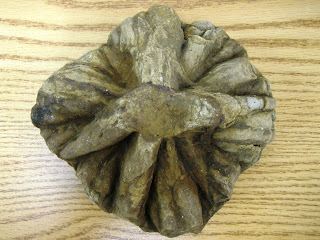A coworker recently brought me two fossils that were collected by an excavator working near Dewart Lake in Kosciusko County, Indiana.
Any paleobotanists out there that can provide suggestions as to what this is? Above is a side view, and below is a top view.
Based on comments to a past post on Get Your Botany On!, I think this may be Sigillaria sp., but I would welcome all suggestions.
Above is a photo of the entire fossil; below is a close-up.
This is well beyond the area of my expertise, so any help is appreciated!
Thursday, March 29, 2012
Wednesday, March 28, 2012
Spring Beauties!
Common throughout the eastern half of North America, Claytonia virginica is just one of those plants that many of us continue to photograph year after year. For some reason the candy stripes are much darker and more prevalent this year! Photos from Bendix Woods and Sebert Woods in northern Indiana, March 25, 2012.



"Without anxiety let us wander on, admiring whatever beauty the woods exhibit." Henry David Thoreau, 1850.
Sunday, March 25, 2012
Field Guides: Help or Hindrance?
Here is a question I find myself wrestling with on a regular basis; are field guides good for the SCIENCE of botany? The more botanically aware I become as a scientist the more convinced I am that they are very often used by the wrong people and for the wrong task.
Famed bryologist Paul Redfern once said that "keys [floras] are written by people that don't need them for people who can't use them". There is a sad truth to this and it is often the mechanism that turns more and more people to field guides. But is this a good thing?
My understanding of field guides is that they are intended for non-professionals (hikers, wildflower enthusiasts, etc.) but I know many professionals that use them as primary references. I fear that this dumbs-down the profession or at the very least gives non-botanist professional scientists a false sense of what it really takes to know a flora.
Anyway, I figured that GYBO has such a mix of professional and nonprofessional botany/ecology people, that it would make for an interesting conversation. Please share your thoughts.
Thursday, March 22, 2012
Plant Quiz
Does anyone recognize this plant? I don't know what it is, but hopefully some of you can provide a name. It's not aromatic at all, but is it an Artemisia? It grows in vacant lots in South Bend, Indiana and is probably a garden escape, but I don't study cultivated plants. I seem to recall seeing it in flower beds somewhere.
Thanks!

Monday, March 19, 2012
That Sure Must Stink!
At Cornell University, the spathe of Amorphophallus titanum (Titan Arum, aka Corpse Plant) has opened, exposing its spadix of smelly flowers. For more information and a live webcam view, visit http://bhort.bh.cornell.edu/Atitanum/index.html.
 |
| Photo from Wikipedia.org |
Sunday, March 11, 2012
Snow Trillium!
Speckled Alder
Alnus rugosa was flowering profusely today in wet ground along the Norfolk Railroad in Starke County, Indiana. The yellowish catkins bear the staminate (male) flowers, while the small, reddish cones contain the pistillate (female) flowers. Photographed March 11, 2012.

Sharp-Lobed Hepatica
Friday, March 9, 2012
Charles Deam Article
On a recent wintry day at the town library, I was walking past the magazine racks and there was our legendary botanist Charles Deam on the cover of "Traces of Indiana and Midwestern History!"

Left to right: Frank
The article inside tells his story very nicely and was written by Jennifer Harrison. The issue date is Fall, 2010, and the article includes several pictures of Mr. Deam that I had not seen before. The extraordinary legacy of this man's passion for botany lives on!
(See also: http://getyourbotanyon.blogspot.com/2012/02/traces-of-charles-deam.html

Photo from Ball State University
Tuesday, March 6, 2012
Erigenia bulbosa, Harbinger of Spring!
Veronica persica, Bird's Eye Speedwell
Sunshine, blue sky, and mild temperatures worked their charm on northern Indiana today, and Bird's Eye Speedwell responded with a few sky-blue corollas. These flowers are quite large as speedwells go, nearly a centimeter in diameter! As the seed capsules develop the peduncles elongate quite noticeably.
 Photographed in the horseman's campground of Potato Creek State Park in St. Joseph County, Indiana on March 6, 2012.
Photographed in the horseman's campground of Potato Creek State Park in St. Joseph County, Indiana on March 6, 2012.
Draba verna, Vernal Whitlow Grass
Little Draba verna is a mustard that flowers very early. It tends to cover a lot of sandy and gravelly places, and is also quite frequent in ag fields that have not yet been planted. In the classic "Sand County Almanac," Aldo Leopold called Draba "a small creature that does a small job quickly and well." It is very possible, however, that he was talking about the related Draba reptans, a sand country native.

Photographed in the horseman's campground at Potato Creek State Park, St. Joseph County, Indiana, on March 6, 2012.
Saturday, March 3, 2012
Green in Winter: Plant Quiz Solved! Blephilia hirsuta
Good call Nate! It is Blephilia hirsuta, Wood Mint. This plant is often associated with alluvial soils and slopes in mesic woodland. The leaves have a very appealing aroma when crushed.
Posted previously:
This plant was photographed on a slope above the Eel River in Miami County, Indiana in mid-February, 2012. Can you identify it? Feel free to name the plant or just take a guess!

Subscribe to:
Posts (Atom)






